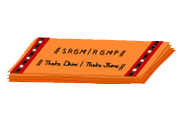Posted By: Administrator
Rāga: Rāgamālikā
Meanings: Rasikas.org; R.Śhankar
Alignment,
Diacriticals & consequent spelling changes, Language & grammar editing,
if any and necessary, of existing meaning: Team Ambalam
(Rāga: Kambhoji)
Āyar Chériyar Arindhidāmalum Annai Thandhaiyar Arindhiḍāmalum
Neyar Gopiyar Nenjam Kavarndhiḍa Māyavan Kuzhal Ūdhurān
Eṅgaḷ Yādhavan Kuzhal Ūdhurān
(Rāga: Ṣhaṇmukhapriya)
Suruṇḍirundha Akkuzhalgal Asaindhiḍa Sundhara Mukham Thulaṅgiḍa
Maruṇḍa Mān Inam Méigai Marandhiḍa Māyavan Kuzhal Ūdhurān
Pavazha Vāyan Kuzhal Ūdhurān
(Rāga: Bilahari)
Siru Viralgaḷ Akkuzhalai Tazhuviḍa Senkamala Kaṇ Imaitthiḍa
Kuruvi Arvai Appuruvam Nerunḍida Gopālan Kuzhal Ūdhurān
Engaḷ Bālan Kuzhal Ūdhurān
(Rāga: Madhyamāvathi)
Govindhan Kuzhal Gītha Nādhamum Gopiyar Sevi Isaitthiḍa
Moham Kondōḍi Vegamāi Vara Kaṇṇanai Dhhyānam Seigirār
Kamala Kaṇṇani Dhhyānam Seigirār
Meanings:
Āyar Chériyar Arindhidāmalum Annai Thandhaiyar
Arindhiḍāmalum
Neyar Gopiyar Nenjam Kavarndhiḍa Māyavan Kuzhal Ūdhurān
Eṅgaḷ Yādhavan Kuzhal Ūdhurān
Āyar = people belonging to the Yadhava clan - cowherds
Chériyar = belonging to the hamlet
Arindhidāmalum = without (their) knowledge
Annai = mothers
Thandhaiyar = fathers
Arindhiḍāmalum = without (their) knowledge
Neyar Gopiyar = (his) lovers (neyar), the gopis (gopiyar)
Nenjam Kavarndhiḍa = (to) captivate (kavarndida) their hearts (nenjam)
Māyavan = the illusionist (krishna)
Kuzhal Ūdhurān = is playing/blowing (uduran) his flute (kuzhal)
Eṅgaḷ = our
Yādhavan = prince of the Yadavas (Krishna symbolizes the entire yadava clan,
and hence, he is called the Yadavan) Kuzhal Ūdhurān
Without the knowledge of the other cowherds of the hamlet, and unbeknownst
to their parents, the prankster and illusionist supreme is playing his flute to
captivate the hearts of the Gopis.
Suruṇḍirundha Akkuzhalgal Asaindhiḍa Sundhara Mukham Thulaṅgiḍa
Maruṇḍa Mān Inam Méigai Marandhiḍa Māyavan Kuzhal Ūdhurān
Pavazha Vāyan Kuzhal Ūdhurān
Suruṇḍirundha = that were (irunda) curled (shurundu)
Akkuzhalgal = those tresses (kuzhalgal)
Asaindhiḍa = as they move (ashaindida)
Sundhara = beautiful/handsome
Mukham = face
Thulaṅgiḍa = shines luminously (tulangida)
Maruṇḍa = entranced
Mān Inam = deer
Méigai = to graze
Marandhiḍa = to forget
Māyavan Kuzhal Ūdhurān - the illusionist (krishna) is playing/blowing (uduran)
his flute (kuzhal)
Pavazha = coral-like
Vāyan = one whose mouth/lips is/are
Kuzhal Ūdhurān - is playing/blowing (uduran) his flute (kuzhal)
As he plays on his flute, his curly locks sway and his handsome face shines
luminously. Entranced by the music, the deer forget to graze, as the
illusionist, the one with coral-like lips plays on his flute.
Siru Viralgaḷ Akkuzhalai Tazhuviḍa Senkamala Kaṇ Imaitthiḍa
Kuruvi Arvai Appuruvam Nerunḍida Gopālan Kuzhal Ūdhurān
Engaḷ Bālan Kuzhal Ūdhurān
Shiru = small
Viralgaḷ = fingers
Akkuzhalai = that flute
Tazhuviḍa = caress
Senkamala = red (shen) lotus-like (kamala)
Kaṇ = eyes
Imaitthiḍa = as they close
Kuruvi Arvai = small beads of perspiration
Appuruvam = his eyebrows
Nerunḍida = as they come close
Gopālan = the cowherd (go = cow - palan - one who minds them)
Kuzhal Ūdhurān - is playing/blowing (uduran) his flute (kuzhal)
Engal = our
Bālan = son (young one)
Kuzhal Ūdhurān - is playing/blowing (uduran) his flute (kuzhal)
As his little fingers caress the flute and bring out enchanting music, his
lotus-like eyes close, as if in a trance, and as beads of perspiration collect
on his forehead and move towards his eyebrows, our Gopala, our young one plays
the flute.
Govindhan Kuzhal Gītha Nādhamum Gopiyar Sevi Isaitthiḍa
Moham Kondōḍi Vegamāi Vara Kaṇṇanai Dhhyānam Seigirār
Kamala Kaṇṇanai Dhhyānam Seigirār
Govindan = krishna's
Kuzhal = flute
Gītha = song
Nādhamum = and music
Gopiyar = of the gopis
Sevi = ears
Isaitthiḍa = to
play music.
Moham = infatuated
Kondōḍi = kondu+ōḍi = run (odi), being filled with/become (kondu)
Vegamāi = fast
Vara = as they come
Kaṇṇanai = krishna
Dhhyānam = meditate upon
Seigirār = they do
Kamala Kaṇṇanai= one with lotus-like (kamala) eyes (kannan)
Dhhyānam = meditate upon
Seigirār = they do
As the song and music from Govinda's flute
entrances the Gopis (as they hear the sweet notes), they come running in
infatuation, and they meditate on the lotus eyed one to attain him.












